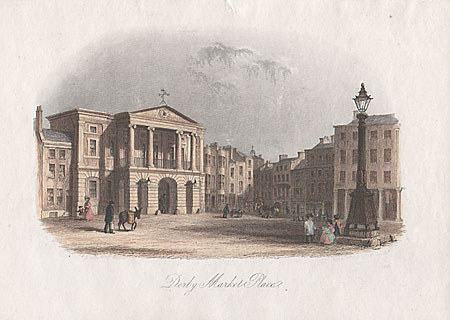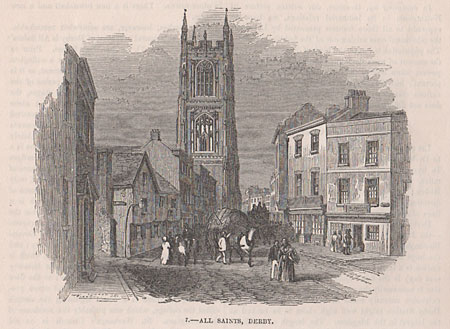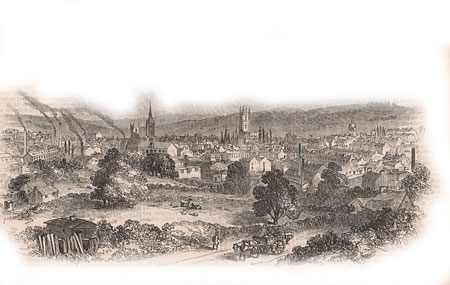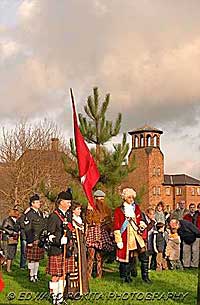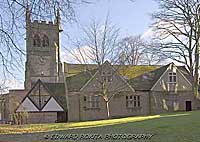Derby City Guide - Guide to the City of Derby in Derbyshire
Short History of Derby
The first human settlement of Derby was by the Romans who built a fort on high ground around Belper Road, overlooking the river Derwent, one of a line of forts seeking to protect the first boundary of their newly conquered province.
Soon realising the importance of the area, around AD80, they moved across the Derwent and built a new fort on the east side calling it Derventio. Gradually a civil settlement grew up around the camp and in the 1970's an industrial suburb of Deventio was discovered on Derby Racecourse, consisting of a 25ft wide road lined with timber buildings, 2 pottery kilns and a cemetery.
The great Roman Road of Rykneld Street connected the garrisons of the wild north with the civilised Roman towns of the south, passed straight through Derventio.
The Romans stayed for over three centuries until the great withdrawal in an attempt to save Rome from the barbarians.
A hundred years later the Saxons arrived in strength, sailing up the river Trent and completing their colonisation of this island. They renamed the Roman fort Little Chester, the name by which it is still known today, and built a village a mile to the south of it which they called Northworthy, with a seperate development growing up and around St Werburghs Church.
This area was ideal with Markeaton Brook providing the water supply. A saxon called Walda started a dairy farm and Walde's Wick, later becoming the Wardwick, was a Saxon Street joining the farm to Northworthy. A town was slowly beginning to form. Many of Derby's suburbs owe their present names to the Saxons who enjoyed 300 years of uninterupted rule until the coming of the Danes who captured Nottingham in AD868.
Soon after, Northworthy and much of the rest of the region was taken. Northworthy was renamed Derby and the town expanded, having a population of about 1200 in AD874.
By 917AD the Anglo Saxons under Ethelfleda, Lady of the Mercians and King Alfred's daughter had won back the town. Under the Danes it had become one of the 5 Danish Boroughs along with Nottingham, Lincoln, Leicster and Stamford. These were the military, administrative and commercial centres for the respective surrounding areas all of which became shires by the late 10th or early 11th century. Eventually a sort of uneasy peace developed between the Waring factions.
By the time of the Domesday survey, the population had fallen. In Domesday it appears that 'Derby was a self contained agricultural community grinding it's own corn, fattening it's own livestock, shaping its own crude farm implements, weaving it's own cloth and even catching it's own fish from the Derwent and eels from Sinfin'.
Six churches are mentioned in Domesday as belonging to the region. They were All Saints, which became Derby Cathedral in 1927, St Alkmunds, which was probably the first one built, but demolished in the late 20C to build a road, St Michaels, St Peters, St Werburghs and St Marys.
By the early part of the 13th century the Market Place was known to have been a busy commercial centre with shops and stalls and first street names appear. Newland Street from around 1190, St James Lane, now Street and Sadler Gate appear about 1250. Walker Lane in 1263, St Mary's Gate in 1265 and Full Street in 1280.
Around the year 1300 Bridge Chapel was built, on the bridge over the river Derwent. It still survives today, one of only six in the country. It was restored by the Derby Archaelogical Society in the 1930's.
Derby School was founded by Queen Mary Tudor in 1554 in St Peter's Churchyard. It still survives today, used by the Derby Heritage Centre.
The tower of All Saint's, now Derby Cathedral, was rebuilt between 1509 and 1530.
Dolphin pub built in the late 16th century. Licence dates from 1580.
County Hall built in St Mary's Gate, in 1660, later to become the Derby Assizes.
Seven Stars pub is dated from 1680.
The Old Bell Hotel in Saddler Gate dates from around the mid 17th century.
In 1702 George Sorocold builds his first Silk Mil in Derby. Rebuilt in 1717.
Medieval church of All Saints demolished and rebuilt around 1725.
The Wardwick Tavern dates from around 1740.
Robert Bakewell dies in 1752. He was a celebrated Derby ironsmith, whose work can still be seen in Derby Cathedral and the Old Silk Mill.
Joseph Pickford, the Derby Architect builds his family house in Friar Gate, in 1770, now known as Pickford's House Museum.
Joseph Wright, celebrated Derby Painter born in 1734.
In 1745 Charles Edward Stuart arrived in Derby on route for his march on London. Troops were sent to hold Swarkestone Bridge, but next day a decision was made not to continue any further.
In 1750 William Duesbury comes to Derby to set up a porceline factory in Nottingham Road. A Royal warrant is granted in 1775 allowing the company to use the term Crown Derby.
In 1801, the first census shows Derby's population to be just under 11000. The 19th century sees the transformation of Derby as a county market town into a hive of industry with attendant crop of civic buildings.
In 1802 Erasmus Darwin, co-founder of the Lunar Society and founder member of the Derby Philosophical Society dies.
In 1810 the Derbyshire Royal Infirmary opened on land formerly part of the Castlefields estate.
In 1821 a new County Gaol was opened in Vernon Street.
In 1825 the Uttoxeter New Road turnpike was opened.
In 1828 the New Guildhall was built. The architect was Mathew Habershon.
In 1831 there were Reform Bill riots in Derby.
By the 1840's census, the population of Derby had more than trebled to 37,000.
In 1840 Derby Railway Station opened. Three companies were to run the railways from Derby- the North Midland which was the largest and most established was controleed by George and Robert Stevenson. The other two were the Birmingham and Derby Company and the Midland Counties Company. The Midland Hotel opposite the station was built around the same time.
In 1842 the town centre was flooded.
In 1843 Joseph Strutt, a derby benefactor, who had given Derby it's first park, dies.
In 1844 the three railway companies amalgamate to form the Midland Railway Company.
IN 1848 the first race meeting was held on Derby Race Course.
In 1850 the first Co-operative society was formed in Derby.
In 1855 Nottingham Road cemetery opens.
In 1858 Derby holds it's first Regatta.
In 1862 Derby saw it's last public execution.
In 1866 the Market Hall was opened.
In 1879 Derby free library and museum opened.
1884 saw the formation of derby County Football Club.
The population of Derby had reached 118000 by 1903.
In 1908 Rolls-Royce establishes it's first presence in Derby.
In 1910 fire destroys much of the old Silk Mill.
In 1916 British Celanese established a factory in Spondon.
In 1927 All Saint's Church becomes a cathedral.
Derby City Hospital opened in 1929.
1n 1932 the Derby Evening Telegraph was formed, a result of a merger by the Derby Daily Express and the Derby Daily Telegraph.
In 1949 the Derby Council House was opened by the then Princess Elizabeth.
In 1962 the Derby Assembly Rooms were destroyed by fire. The facade was eventually moved to Crich Museum where it still stands.
Derby Eagle Centre was opened in 1975, despite much local opposition. The Derby Playhouse in the Eagle centre was also opened the same year.
In 1977 Derby becomes a City.
The New Derby Assembly Rooms built in the late 1970's, dramatically changing the scene around the Market Place.
In 1992 Derby University was founded.
In 1994 much of the city centre was pedestrianised.
In 2005 Derby Bus Station closes in preparation for many changes around the City centre including the building of a new Shopping Mall.
See Derby Cinema History for information of some bygone picture houses and the films they showed.
|
Derby City Guide : Disclaimer |


